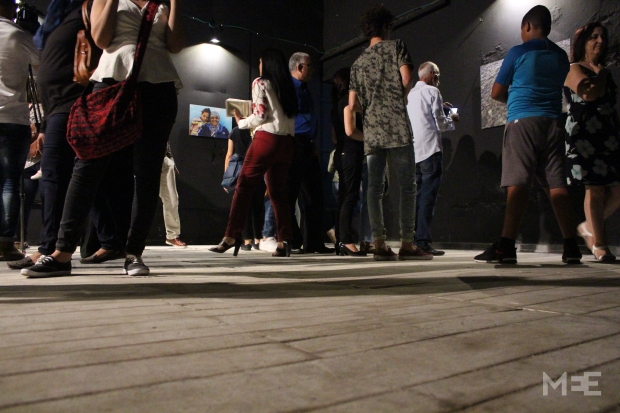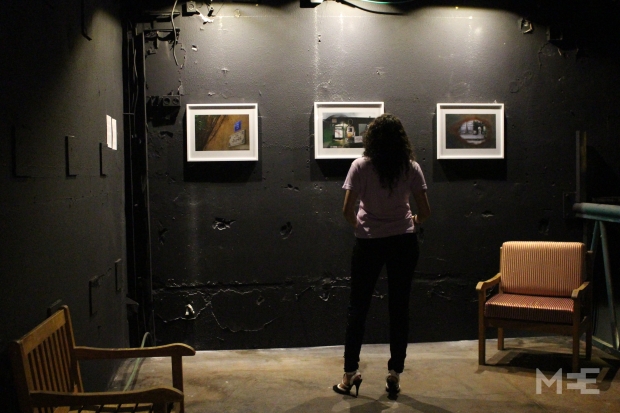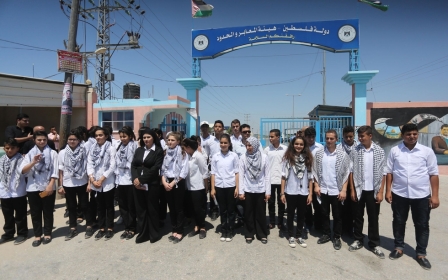'The Sea': A metaphor for the Palestinian right of return
HAIFA, Israel - In a small, darkened corner of Haifa’s former city hall, the sound of crashing waves can be heard above the murmur of gallery-goers filling the building’s second floor. For those with a keen sense of hearing, the sound led to a solitary space amid the crowds – an immersive three-sided video installation of the sea at eye level, which left viewers feeling something like a human buoy.
It was a warm Tuesday evening, and the Arab Culture Association had just opened People of the Sea – a photography exhibition focusing on just that – the sea, and the way people, particularly Palestinians, relate to it. The source of the waves was just one of the lens-based works on show, a video loop by Khalood Basel Tannous, titled Aquifer.
But the exhibition and its opening night were also representative of something bigger – the month-long biennial celebration of Palestinian art and culture known as Qalandiya International. In its third and easily largest installment, this year’s festival truly embraced the "international" half of its name. While Eyad Barghouti, head of the Arab Cultural Association, welcomed everyone to the festival’s Haifa outpost, the same was playing out in Amman, Beirut, Gaza and London, each with its own distinct exhibition opening simultaneously, linked by a common theme: the sea.
The sea, the Nakba, and the right of return
Qalandiya International began in 2012 as a combined effort of several Palestinian cultural organisations to promote contemporary Palestinian art locally and globally. Centred around Ramallah and Jerusalem, the festival reclaimed the name Qalandiya, which had long-since become synonymous with the Israeli checkpoint that cuts the West Bank off from Jerusalem, a looming, grey-walled symbol of the ongoing Israeli occupation.
But by embracing the moniker, it also embraced Qalandiya’s other meanings – the refugee camp, former airport, and Palestinian village of the same name. Qalandiya, the festival said in its first year, "is where paradoxes meet".
Four years on, the festival has grown exponentially and the organisers have taken the idea of paradoxes to another level. The 2016 edition unites the efforts of 16 art and cultural organisations with the phrase-turned-theme This Sea is Mine as a way of investigating how the sea has been omitted from the Palestinian narrative of the 1948 Nakba (catastrophe) - when over 700,000 Palestinians were forcefully expelled during the creation of the state of Israel - and the Palestinian right of return.
“It is our duty to respond to the questions of the Palestinian people,” Barghouti said of the theme on the day before the inaugural opening in Haifa. “The loss of the sea, a basic component of the homeland and this spiritual geography, this restricts the sea to the cultural. The idea of the sea can extract ‘return’ from the limited arena of politics to the intuitive arena of human beings. We are collecting the dismantled and separated parts of our people."
The right of return remains central to Palestinian identity and a familiar visual identity has grown around it – the key, the identity card, the pre-1948 map are, in 2016, widespread and well-known Palestinian symbols. But for those organising Qalandiya International, this year’s biennial was an opportunity to expand on that visual language. Turning outwards, the sea was a new way to tackle the concept.
“Why did we choose return? Return is renewing itself and Palestinians are still living the Nakba,” Mahmoud Abu Hashhash added. Hashhash, the director of the Culture and Arts Programme at the AM Qattan Foundation, has been involved in the biennial since its inception. “This makes the question of return present and urgent. Unfortunately, before, the right of return was very much about Palestinian refugees, but now we talk about return and we talk about the right of millions of new refugees around the world who also dream to go back to their cultures and their homes. So the whole concept of return has been expanded and opened up to become multi-layered.”
Uniting Palestine across borders
Taking the idea of the sea as a starting point, the 16 different organisations involved in Qalandiya had free reign to interpret and display the common theme. Places like the Qattan Foundation and the Al Ma’mal Foundation for Contemporary Art in Jerusalem, who helped found the festival, advised and aided newcomers, including the Dar el-Nimer Centre for Arts and Culture in Beirut, and the Palestinian Museum in Birzeit.
The programme is impressive and diverse – spread out across eight different cities, with much of the work focusing on contemporary photography and video. Supplemented by performances, film screenings, workshops, and "Qalandiya Encounters" days of lecture series, the festival is perhaps the largest-scale cultural project to ever centre around Palestine.
“Bringing 16 organisations together, and being able to do such a massive project, I really see this as a large success for us,” Aline Khoury, told Middle East Eye. In her day job, Khoury works as programme coordinator for the Al Ma’mal Foundation for Contemporary Art, in Jerusalem, but also volunteered her time as the festival’s media coordinator. “I don’t think anything like this has happened, where Palestinians have come together in this sort of way, and networked.”
The network and its exchange of ideas, she said, is in itself a way of helping enhance the dialogue surrounding Palestinian art in more diverse ways.
“Being a part of Qalandiya, you are able to share joint struggles and challenges,” Khoury said. We have been able to share our experiences. I’ve been able to learn from my other partners in Qalandiya, and so in a way it is helping Al Ma’mal itself.”
By extending the festival to places in the diaspora, like Amman, Beirut and London, Hashhash hopes to reach places that single institutions would not be able to reach on their own.
“To bring the Palestinian issue and questions to other people around the world, this is also one of the good side effects we would like to achieve,” he told MEE. “And also to contribute internally to the discussion and the decision-making process regarding such a right. And as institutions, we are practising the role that we should do and trying to be by gathering these efforts together, to be more impactful on society and on our context, and also to go beyond where we used to go and where we were able to go as individual institutions.”
Questioning the meaning of heritage
Over 200 artists and curators will continue presenting work through the month of October, with Ramallah acting as a home base for many of the festival’s lectures and performances. In the de-facto Palestinian capital, the municipality has taken over a number of disused buildings and public spaces to host Sites of Return, with a variety of work ranging from the paintings of established Palestinian painter Samia Halaby to an installation by Campus in Camps - an experimental education programme that operates within Palestinian refugee camps - that sees an Arabic calligrapher documenting stories collected from Palestinian refugee camps post-Nakba.
Down the street from the municipality’s Sites of Return, curator Nat Muller discussed the trends in contemporary Palestinian art. Pattern Recognition, the exhibition she curated along with the Qattan Foundation, showcases the work shortlisted for their Young Artist of the Year Award.
“I think that there are always going to be the themes that run through Palestinian artistic practices that have to do with territory, and memory, and state of suspension and violence and the occupation, issues of identity,” Muller said.
“Looking back a few years, there is actually a consideration of their own art history - not only artists looking at their environment and trying to make work, but at what area the aesthetic decisions and visual language that has preceded them. I think there is also a consideration with science fiction, and humour, a certain lightness, which maybe ten years ago you wouldn’t have seen, but it’s becoming a very interesting critical strategy.”
Looking back at previous aesthetic decisions is something that RIWAQ, the Centre for Architectural Conservation, does on a daily basis. For their Qalandiya offering, RIWAQ has organised "A Series of Uncurated Events" which includes hikes into the Palestinian wilderness, and exhibitions hosted in previously restored buildings.
At Hosh al-Etem in Birzeit, a centre for architectural conservation, architect Yousef Taha explained his project of recreating the Ottoman clocktower that once stood above Jaffa Gate in the Old City of Jerusalem – the largest 3-D printed project to come out of Palestine.
“The whole idea is to question the meaning of our heritage that goes from generation to generation, and what stays in memory from generation to generation,” he said, noting the clock tower was removed during the British Mandate for appearing too "modern" for British officials. “The whole idea about this artwork is to show the old pictures and remodel what has been missed out forever, so we may really question what is the meaning of heritage – it’s the thing, the memory, that goes from generation to generation.”
Middle East Eye propose une couverture et une analyse indépendantes et incomparables du Moyen-Orient, de l’Afrique du Nord et d’autres régions du monde. Pour en savoir plus sur la reprise de ce contenu et les frais qui s’appliquent, veuillez remplir ce formulaire [en anglais]. Pour en savoir plus sur MEE, cliquez ici [en anglais].







